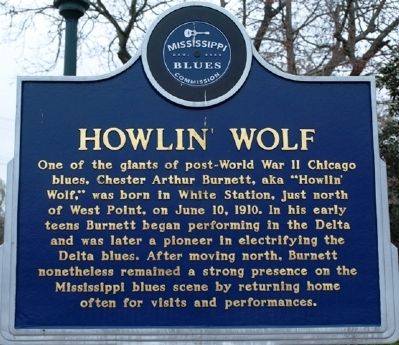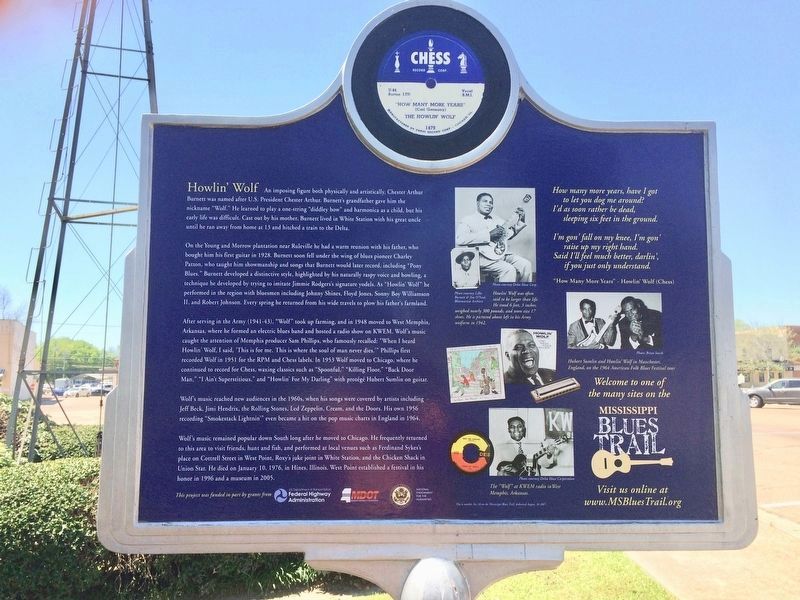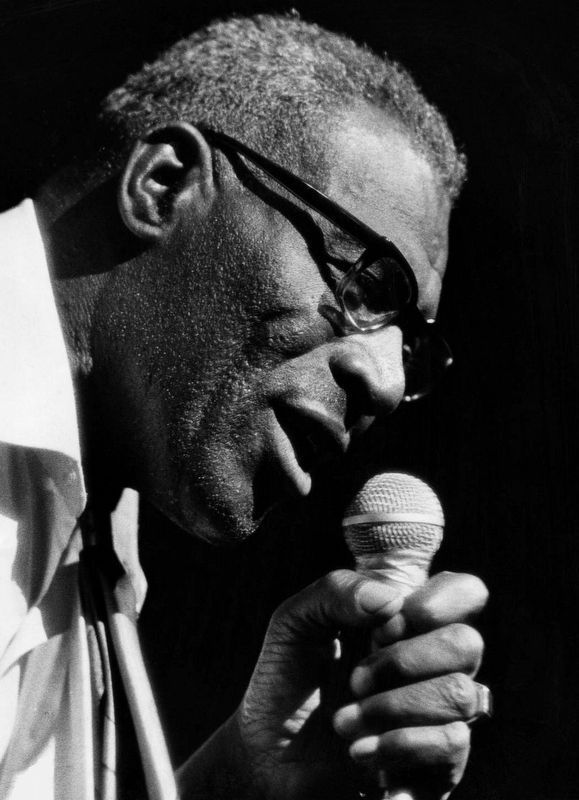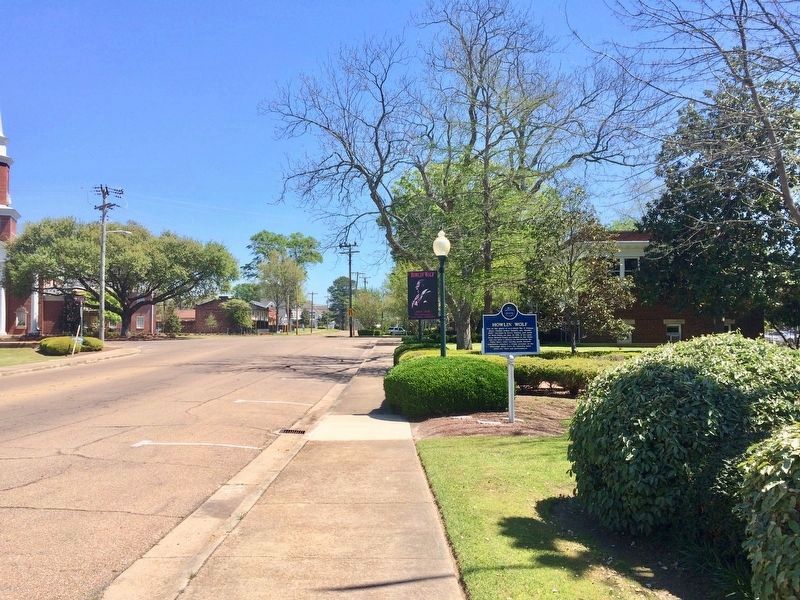West Point in Clay County, Mississippi — The American South (East South Central)
Howlin' Wolf
(Back):
An imposing figure both physically and artistically, Chester Arthur Burnett was named after U.S. President Chester Arthur. Burnett’s grandfather gave him the nickname “Wolf.” He learned to play a one-string “diddley bow” and harmonica as a child, but his early life was difficult. Cast out by his mother, Burnett lived in White Station with his great uncle until he ran away from home at 13 and hitched a train to the Delta.
On the Young and Morrow plantation near Ruleville he had a warm reunion with his father, who bought him his first guitar in 1928. Burnett soon fell under the wing of blues pioneer Charley Patton, who taught him showmanship and songs that Burnett would later record, including “Pony Blues.” Burnett developed a distinctive style, highlighted by his naturally raspy voice and howling, a technique he developed by trying to imitate Jimmie Rodgers’s signature yodels. As “Howlin’ Wolf” he performed in the region with bluesmen including Johnny Shines, Floyd Jones, Sonny Boy Williamson II, and Robert Johnson. Every spring he returned from his wide travels to plow his father‘s farmland.
After serving in the Army (1941-43), “Wolf” took up farming, and in 1948 moved to West Memphis, Arkansas, where he formed an electric blues band and hosted a radio show on KWEM. Wolf’s music caught the attention of Memphis producer Sam Phillips, who famously recalled: "When I heard Howlin' Wolf, I said, 'This is for me. This is where the soul of man never dies.'" Phillips first recorded Wolf in 1951 for the RPM and Chess labels. In 1953 Wolf moved to Chicago, where he continued to record for Chess, waxing classics such as “Spoonful,” “Killing Floor,” “Back Door Man,” “I Ain’t Superstitious,” and “Howlin’ For My Darling” with protégé Hubert Sumlin on guitar.
Wolf’s music reached new audiences in the 1960s, when his songs were covered by artists including Jeff Beck, Jimi Hendrix, the Rolling Stones, Led Zeppelin, Cream, and the Doors. His own 1956 recording “Smokestack Lightnin’” even became a hit on the pop music charts in England in 1964.
Wolf’s music remained popular down South long after he moved to Chicago. He frequently returned to this area to visit friends, hunt and fish, and performed at local venues such as Ferdinand Sykes’s place on Cottrell Street in West Point, Roxy’s juke joint in White Station, and the Chicken Shack in Union Star. He died on January 10, 1976, in Hines, Illinois. West Point established a festival in his honor in 1996 and a museum in 2005.
Erected 2007 by the Mississippi Blues Commission. (Marker Number 18.)
Topics and series. This historical marker is listed in these topic lists: African Americans • Arts, Letters, Music • Entertainment. In addition, it is included in the Mississippi Blues Trail series list. A significant historical month for this entry is January 1839.
Location. 33° 36.28′ N, 88° 38.809′ W. Marker is in West Point, Mississippi, in Clay County. Marker is on East Broad Street east of Commerce Street, on the right when traveling east. Touch for map. Marker is at or near this postal address: 510 East Broad Street, West Point MS 39773, United States of America. Touch for directions.
Other nearby markers. At least 8 other markers are within 4 miles of this marker, measured as the crow flies. Clay County World War I Memorial (within shouting distance of this marker); West Point (about 300 feet away, measured in a direct line); Waverley (approx. 0.7 miles away); Mary Holmes College (approx. 1.2 miles away); Chickasaw Burial Ground (approx. 2.4 miles away); Prehistoric Indian Burial Mound (approx. 2.4 miles away); Indian Camp Ground (approx. 2.4 miles away); Payne Field Site (approx. 3.2 miles away). Touch for a list and map of all markers in West Point.
Credits. This page was last revised on August 30, 2017. It was originally submitted on December 9, 2011, by Jeff Lovorn of Florence, Mississippi. This page has been viewed 1,169 times since then and 64 times this year. Photos: 1. submitted on December 9, 2011, by Jeff Lovorn of Florence, Mississippi. 2. submitted on April 9, 2017, by Mark Hilton of Montgomery, Alabama. 3. submitted on December 13, 2016, by Mark Hilton of Montgomery, Alabama. 4. submitted on April 9, 2017, by Mark Hilton of Montgomery, Alabama. • Craig Swain was the editor who published this page.



